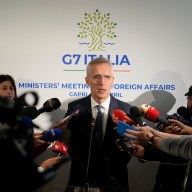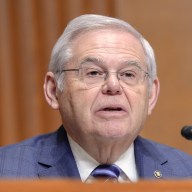NEW YORK, N.Y. – Budget-conscious diners continue to flock to McDonald’s, but investors are beginning to worry about the fast food giant’s higher prices and upcoming expenses.
After the company reported Tuesday that net income jumped 11 per cent in the fourth quarter on Tuesday, CEO Jim Skinner said his company can perform well in any economy.
But Skinner also noted that the struggling global economy, volatile costs for ingredients and low consumer confidence present a challenge for the world’s biggest burger chain.
McDonald’s, which serves as a bellwether for the fast-food industry, has done well throughout the recession and its aftermath with a two-pronged strategy. It’s continued to attract a base of cash-strapped customers by keeping prices low, while also luring in new customers with offerings like smoothies, lattes, and remodeled restaurants.
In the fourth quarter, McDonald’s net income of $1.38 billion translated to $1.33 per share, beating the $1.29 predicted by analysts polled by FactSet. Revenue jumped 10 per cent to $6.82 billion, slightly above expectations of $6.81 billion.
But the profit margin fell slightly at company-operated stores. The company blamed higher commodities costs, as well as rising costs for rent and labour in Europe, Asia, the Middle East and Africa. Its effective tax rate for the year increased to 31.3 per cent from 29.3 per cent, which the company indicated was partly from higher taxes in Europe.
On the news, McDonald’s shares were down 2.2 per cent to $98.75 Tuesday.
Foreign currency exchange rates, which helped in previous quarters, did not boost this quarter’s results. Such rates were neutral during the quarter as the dollar strengthened. When the dollar is weak, revenue that McDonald’s makes overseas translates into more dollars in the U.S.
Higher costs for ingredients also continue to be an issue, even though costs for some ingredients, like wheat and corn, have levelled off. McDonald’s said it expects costs for most of its commodities in the U.S. to increase 4.5 to 5.5 per cent in 2012, in line with 2011’s 4.9 per cent increase. Last year, McDonald’s raised menu prices three times, for a total price increase of about 3 per cent, in March, May and November.
Chief financial officer Pete Bensen said the company would continue to “strategically take increases to offset some but not all of our higher costs.”
Bensen added that McDonald’s would take “a balanced approach to growing traffic and average check” as it mulled further price increases. The company doesn’t want to raise prices too much and risk driving away customers or causing them to trade down to cheaper items.
Like many companies, McDonald’s is looking for revenue growth in emerging markets like China and Africa, where fast-growing populations present both high risk and high potential rates of return. Skinner said McDonald’s plans to open a net of 900 new restaurants in the coming year, concentrated in Asia, the Middle East and Africa, to add to the current roster of 33,500-plus locations around the world.
About 22 per cent of McDonald’s revenue comes from Asia Pacific, Africa and the Middle East, up from 14 per cent five years ago. That region grew revenue 13 per cent over the year, faster than any other.
In the U.S., McDonald’s will focus on getting more customers into the existing 14,000-plus locations. Skinner said the approach was “not rocket science.”
“A lot of it is simple things like proper scheduling, positioning and then planning for your shift, planning for that time period from 11 (a.m.) to 1 (p.m.) for example to be able to facilitate faster service, and fast service begets more customers,” Skinner said.
Revenue in Europe, which accounts for the biggest slice of total revenue — 40 per cent — grew by 9 per cent. New items, like hamburger bagel sandwiches, helped the company maintain revenue despite the region’s “ongoing economic uncertainty.” Executives said they see room for growth in the drive-thru business and breakfast sales there.
The company said it continues to set aside money for renovating restaurants, which it sees as key to attracting new customers. Globally, McDonald’s has renovated about 45 per cent of its restaurants’ interiors and 25 per cent of the exteriors. But the all the remodeling has needled some franchisees who have share in the costs.
Mark Kalinowski, an analyst at Janney Capital Markets, reduced his per-share earnings estimate for this year and next on the foreign currency impact and upcoming spending. McDonald’s said it expected selling, general and administrative expenses to jump 6 per cent in 2012, driven by investments in restaurants as well as spending on the London Olympics and a convention for owner-operators.















